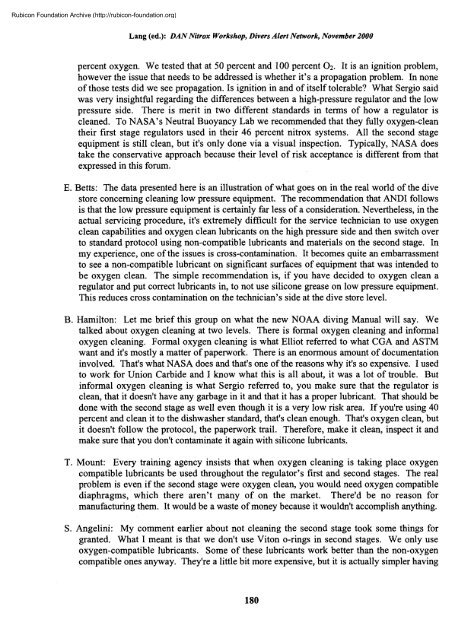Nitrox workshop dings - Divers Alert Network
Nitrox workshop dings - Divers Alert Network
Nitrox workshop dings - Divers Alert Network
Create successful ePaper yourself
Turn your PDF publications into a flip-book with our unique Google optimized e-Paper software.
Rubicon Foundation Archive (http://rubicon-foundation.org)Lang (ed.): DAN <strong>Nitrox</strong> Workshop, <strong>Divers</strong> <strong>Alert</strong> <strong>Network</strong>, November 2000percent oxygen. We tested that at 50 percent and 100 percent O2. It is an ignition problem,however the issue that needs to be addressed is whether it's a propagation problem. In noneof those tests did we see propagation. Is ignition in and of itself tolerable? What Sergio saidwas very insightful regarding the differences between a high-pressure regulator and the lowpressure side. There is merit in two different standards in terms of how a regulator iscleaned. To NASA's Neutral Buoyancy Lab we recommended that they fully oxygen-cleantheir first stage regulators used in their 46 percent nitrox systems. All the second stageequipment is still clean, but it's only done via a visual inspection. Typically, NASA doestake the conservative approach because their level of risk acceptance is different from thatexpressed in this forum.E. Betts: The data presented here is an illustration of what goes on in the real world of the divestore concerning cleaning low pressure equipment. The recommendation that ANDI followsis that the low pressure equipment is certainly far less of a consideration. Nevertheless, in theactual servicing procedure, it's extremely difficult for the service technician to use oxygenclean capabilities and oxygen clean lubricants on the high pressure side and then switch overto standard protocol using non-compatible lubricants and materials on the second stage. Inmy experience, one of the issues is cross-contamination. It becomes quite an embarrassmentto see a non-compatible lubricant on significant surfaces of equipment that was intended tobe oxygen clean. The simple recommendation is, if you have decided to oxygen clean aregulator and put correct lubricants in, to not use silicone grease on low pressure equipment.This reduces cross contamination on the technician's side at the dive store level.B. Hamilton: Let me brief this group on what the new NO A A diving Manual will say. Wetalked about oxygen cleaning at two levels. There is formal oxygen cleaning and informaloxygen cleaning. Formal oxygen cleaning is what Elliot referred to what CGA and ASTMwant and it's mostly a matter of paperwork. There is an enormous amount of documentationinvolved. That's what NASA does and that's one of the reasons why it's so expensive. I usedto work for Union Carbide and I know what this is all about, it was a lot of trouble. Butinformal oxygen cleaning is what Sergio referred to, you make sure that the regulator isclean, that it doesn't have any garbage in it and that it has a proper lubricant. That should bedone with the second stage as well even though it is a very low risk area. If you're using 40percent and clean it to the dishwasher standard, that's clean enough. That's oxygen clean, butit doesn't follow the protocol, the paperwork trail. Therefore, make it clean, inspect it andmake sure that you don't contaminate it again with silicone lubricants.T. Mount: Every training agency insists that when oxygen cleaning is taking place oxygencompatible lubricants be used throughout the regulator's first and second stages. The realproblem is even if the second stage were oxygen clean, you would need oxygen compatiblediaphragms, which there aren't many of on the market. There'd be no reason formanufacturing them. It would be a waste of money because it wouldn't accomplish anything.S. Angelini: My comment earlier about not cleaning the second stage took some things forgranted. What I meant is that we don't use Viton o-rings in second stages. We only useoxygen-compatible lubricants. Some of these lubricants work better than the non-oxygencompatible ones anyway. They're a little bit more expensive, but it is actually simpler having180
















